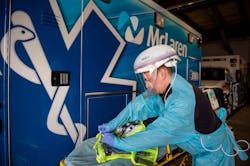Control+Alt+Delete: Effects of COVID-19 on Fire/EMS Today and in the Future
Editor's note: Find Firehouse.com's complete coverage of the COVID-19 pandemic here.
In a literal world of crisis, concern, and confusion we find ourselves looking at the here and now. Daily, we read our emails and social media feeds seeing the sheer terror that COVID-19 is bringing to our country. I asked myself, what is this doing to our society? What is this doing to our profession? What is this doing to us? Rather than write an article about what COVID-19 is or what it does, I wanted to answer these very personal and real questions. I wanted to address the matters that literally impact us on a day to day basis.
You might be sitting in your station right now or maybe you’re doing your part by adhering to the social distancing requirements put in place by our government. Either way, we are all playing a role in this pandemic. We are considered essential which puts us all in a special place. We go to work like any other day and yet every morning feels like an early Sunday morning with no one on the road other than those who are essential alike. It is truly an eerie feeling.
This is affecting much more than just daily life. It is affecting our future in public service. We are constantly being bombarded with information and it is exhausting just sifting through it all. Our energy levels are low while our stress levels are high. It is imperative to maintain a healthy mindset and lifestyle to continue to help all of our citizens the way they deserve.
Defining a real emergency
Let me paint a picture for you. When this pandemic broke out, we anticipated pure chaos. We began thinking about having to work significantly more than we did in the past when it comes to call volume. Even though I work in Washington State, which is currently ranked 7th in the country for COVID-19 cases, our call volume has not been affected. In fact, we have seen a decrease in 9-1-1 responses by 20 percent compared to last year. And this statistic is not just the case for my department. When speaking to friends and colleagues from around the country, they are also seeing a “significant decrease” in call volume.
Why is this happening? Why is it that all of a sudden, we are doing less during a pandemic? It feels like we should be running our butts off. Now this is purely a hypothesis, which is the intent of this entire reading, but could people be starting to learn what is, and what is not an emergency? For years, we have been begging the call gods to stop sending us to 9-1-1 responses that are not emergencies. At this point, they have answered. Our hospitals are experiencing the same results. My local ER is experiencing a 45 percent decrease in patients daily and even our walk-in clinic is reporting about a 50 percent decrease in visits. Is it possible this is just be the calm before the storm?
Being a paramedic, I remember going through training 10 years ago when we were told that we would only really make a difference in approximately four percent of the runs we went on, in terms of Advanced Life Support. At that time, it was absolutely true, but since then it has decreased. What I mean is our call volume is normally increasing, yet our true emergencies are not, which in turn is increasing the percentage of our critical or high acuity patients. But I still have not answered why we are running less.
During my patient assessments and discussions with other providers around the country, it seems we have some significant procedural changes that have been made over the past few weeks. Before COVID-19 we always told people if they wanted to go to the hospital, we would take them, even if it meant they were going to triage. We would try to convince them to see their primary care provider (PCP) or be seen at a walk-in clinic or urgent care when they had lower acuity complaints, however if they still requested transport via ambulance, we would oblige them. Now we have a leg to stand on when it comes to triaging our patients. We triage these patients with the overall goal of keeping an emergency department clear for those who are critically ill and for the safety of our patients in an effort to keep them away from a higher likelihood of contracting a deadly illness, for example: COVID-19. We can also give thanks to successful public outreach information via many different platforms to identify appropriate steps for people with illness to take, for example: call their doctor before going to an emergency room. And to be honest, there are people who are just scared to go to a hospital right now because of the pandemic.
Protecting responders
Using telemedicine
In today’s day and age, we are able to use technology to our advantage. With how busy it has been the past few years with long lines and extended wait times to see a physician, there is now the ability to use technology to get the care you want from the comfort of your own home. Telemedicine using video, phone call and chatting have delivered another viable option to getting the care you and your patient need. Advise your patients of those abilities in your area the next time you see it as an appropriate avenue.
The harsh reality
When titling this article “Control+Alt+Delete” I put great thought toward the message. Are we going to be talking about what we are doing today or what we are going to be doing in the future? Here in the upcoming weeks and months, crap is going to hit the fan and the country as a whole is going to be hammered by this virus and we are all in it together. At the same time, we are resetting the entire healthcare system. We are finding out what works and what doesn’t. We are putting procedures in place to keep our patients and ourselves safe. We are triaging our patients and giving them more or less “stern guidance” into a better treatment path to keep everyone safe.
But most of all we are working with each other more efficiently. We are working with partners we don’t work with nearly as much as we should. From Public Health to Division of Emergency Management to the Federal Emergency Management Agency. We are creating channels to grow from in the future of public service that will only benefit the country as a whole. It is our time to shine! So, while you are preparing, continue to inform your loved ones, friends and whoever else you can, about the appropriate actions to take. Wash your hands, cough into your elbow, call your PCP. Follow these steps and we will go a long way.
The past few weeks and the months to come are monumental for fire, EMS and healthcare as a whole. We are in a state of change where we are separating ourselves from our traditional daily normality’s and becoming comfortable with being uncomfortable. Let’s use these troubling times to institute change and rewrite our future for not only our country, but the world as a whole. It is our responsibility. Please stay safe and wash your damn hands.
About the Author

Brandon Heggie
Brandon Heggie is a lieutenant firefighter/paramedic who has worked in fire and EMS for more than a decade. He served as a tactical medic on a SWAT team and is involved in high-angle rope rescue. Heggie provides in-depth knowledge in aggressive, simplistic medical assessment and care. He obtained an associate degree in emergency medicine and health services. As an instructor, Heggie provides a high-energy educational approach to maximize the learning experience and taught at Firehouse World and Firehouse Expo.


